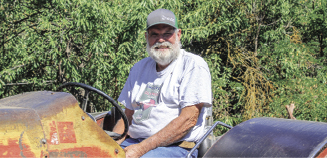From the Fields - Tim Sanders

Photo/Courtesy Tim Sanders
By Tim Sanders, Stanislaus County almond farmer
There’s always something to do when you’ve got almonds. We’re cutting up dead limbs and doing spot spraying on the weeds, preparing the orchard for harvest, which is just around the corner. I’m working on some of the equipment, putting a new sand belt on my pickup machine, just normal everyday things you do during the summer.
The crop is a little bit lighter. On my late varieties, the Butte/Padres look better than my nonpareils and Carmels. This was a year I wanted to see how the self-fertile varieties would do. I’ve got a block of Independence, and they look pretty good, so I think the self-fertile varieties did better this year than the nonpareils. But it’s real spotty. You can look in one part of the orchard, and it looks pretty good, and then the other part of the orchard, there’s hardly anything.
I’ve got a young orchard that I take care of for a lady in Turlock. They’re third-leaf trees, and we put some bees out there, but I didn’t see a bee for a week when the almonds were in full bloom. The owner said, “I don’t think there’s enough nuts to harvest.” The weather this spring just wasn’t inducive to having a big crop. Rainy and cold—it just wasn’t very good pollination weather.
I’m surprised we have the crop that we do have. It’s touch and go, but it’s not as bad as I thought it was going to be. The third-leaf trees that didn’t set a crop—the nonpareils and Montereys—I’m not too concerned about that because we’re going to have a stronger tree overall.
We don’t have to worry about water this year, so that’s a plus. We’re thankful that we’ve got the snow and the rain, and we’re thankful that the weather hasn’t been real hot. The snow is melting at a reasonable rate, so we can capture what we can. My outlook is positive.




